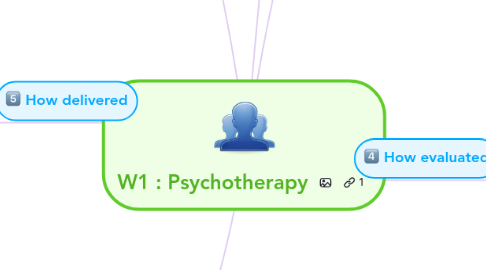
1. How delivered
1.1. individual
1.2. Family
1.3. Couple
1.4. Therapeutic communities
1.5. E-therapy
2. What
2.1. Definition
2.1.1. The treatment of mental disorders by psychological means
2.1.2. Specialised formal interaction between a mental health practitioner and a client in which a therapeutic relationship is established to help to resolve symptoms ;
2.1.2.1. mental disorder,
2.1.2.2. psychosocial stress
2.1.2.3. difficulties in coping in the social environment.
2.1.2.4. relationship problems
2.1.3. psychological approach to relieving human suffering
2.2. Driven and base
2.2.1. Theory driven
2.2.1.1. Precision & testability
2.2.1.2. Parsimony – the simplest explanation for the data
2.2.1.3. Practicality – readily applied
2.2.1.4. Stimulation – it gets people excited!
2.2.1.5. Empirical validity – case study; RCT; meta-analysis
2.2.2. Evidence based
2.3. Stages
2.3.1. Assessment & observation
2.3.2. Case formulation
2.3.3. Intervention plan
2.3.4. Intervention implementation
2.3.5. evaluation
3. Why work
3.1. common vs specific
3.1.1. observe similarities among outcome shows there are commonalities (commonalities) among therapies
3.2. Lambert & Barley (2001) suggest
3.2.1. 15% expectancy effect
3.2.2. 40% Extra-therapeutic change
3.2.3. 15% Techniques
3.2.4. 30% Therapeutic Alliance
3.3. common factor : therapeutic relationship
3.3.1. Therapist variables (interpersonal style, therapist attribute)
3.3.2. Facilitative factors (therapist’s empathy, respect, nonjudgmental attitude)
3.3.3. Therapeutic alliance:
3.3.3.1. ▪ Tasks: behaviours & processes that constitute the work of therapy
3.3.3.2. ▪ Bonds: trust, confidence & acceptance between client & therapist
3.3.3.3. ▪ Goals: objectives of therapy that both client & therapist endorse
3.4. Dodo Theory : all work equivalently
3.5. disagree with Dodo Theory
3.5.1. legitimate outpatient in a group?
3.5.1.1. CBT is better for non-directive relationship with anxiety
3.5.1.2. exposure therapy is better than relaxation therapy for OCD
3.5.2. legitimate to collapse across treatments?
3.5.2.1. Eg., Collapsing across systemic, existential, transpersonal, client centred, psychodynamic, experiential and then label them as a group -“dynamic therapies "
4. Who
4.1. Registered
4.1.1. Psychologist
4.1.2. Psychiatrist
4.1.3. Allied health (mental health nurse)
4.2. Non-registered
4.2.1. social workers
4.2.2. Counsellors
4.2.3. psychotherapist
5. How evaluated
5.1. single case study design (N=1)
5.1.1. character
5.1.1.1. repeated measurements of an individual’s behaviour
5.1.1.2. comparisons across experimental conditions imposed on individual
5.1.1.3. measurements’ reliability within & across the conditions
5.1.2. Intervention only (B)
5.1.3. Baseline-intervention (A-B)
5.1.3.1. Changes in dependent measure between A and B phases may be due to B, or may be due to alternative explanations: History Maturation Testing effects
5.1.4. A-B-A-B
5.1.4.1. successive condition
5.2. efficacy studies
5.2.1. internal validity
5.2.1.1. Controlling the types of patients in the study (e.g. limiting comorbidity)
5.2.1.2. Using manuals to standardise treatment delivery
5.2.1.3. Training and monitoring therapists
5.2.1.4. Controlling the number of treatment sessions
5.2.1.5. Random assignment to conditions & use blind raters
5.3. Cochrane library reviews
5.4. Effectiveness
5.4.1. real life (naturalistic clinical situation
5.4.2. external validity (vice versa with internal)
5.4.3. effect size based on within subject from pre to post intervention
5.4.4. EFFECTIVE!
5.4.4.1. average client improved 80% compared to not treated
5.4.4.2. Psychoteraphy is better than placebo and control (do-nothing or wait)
5.4.5. Clinical treatment guidelines
5.4.5.1. National Centre for Posttraumatic Mental Health (Australia)
5.4.5.2. National Institute for Clinical Excellence (NICE) in UK
